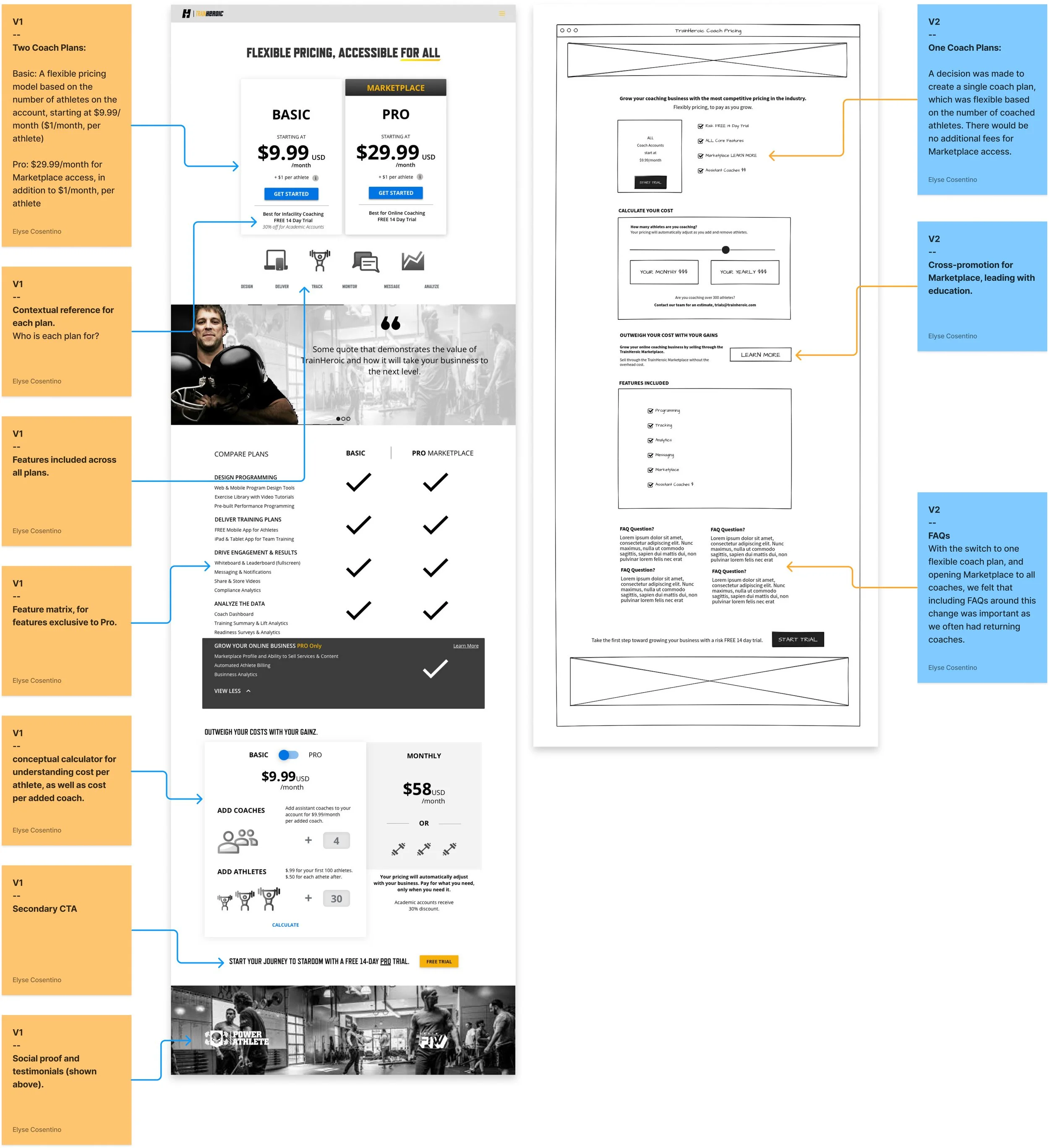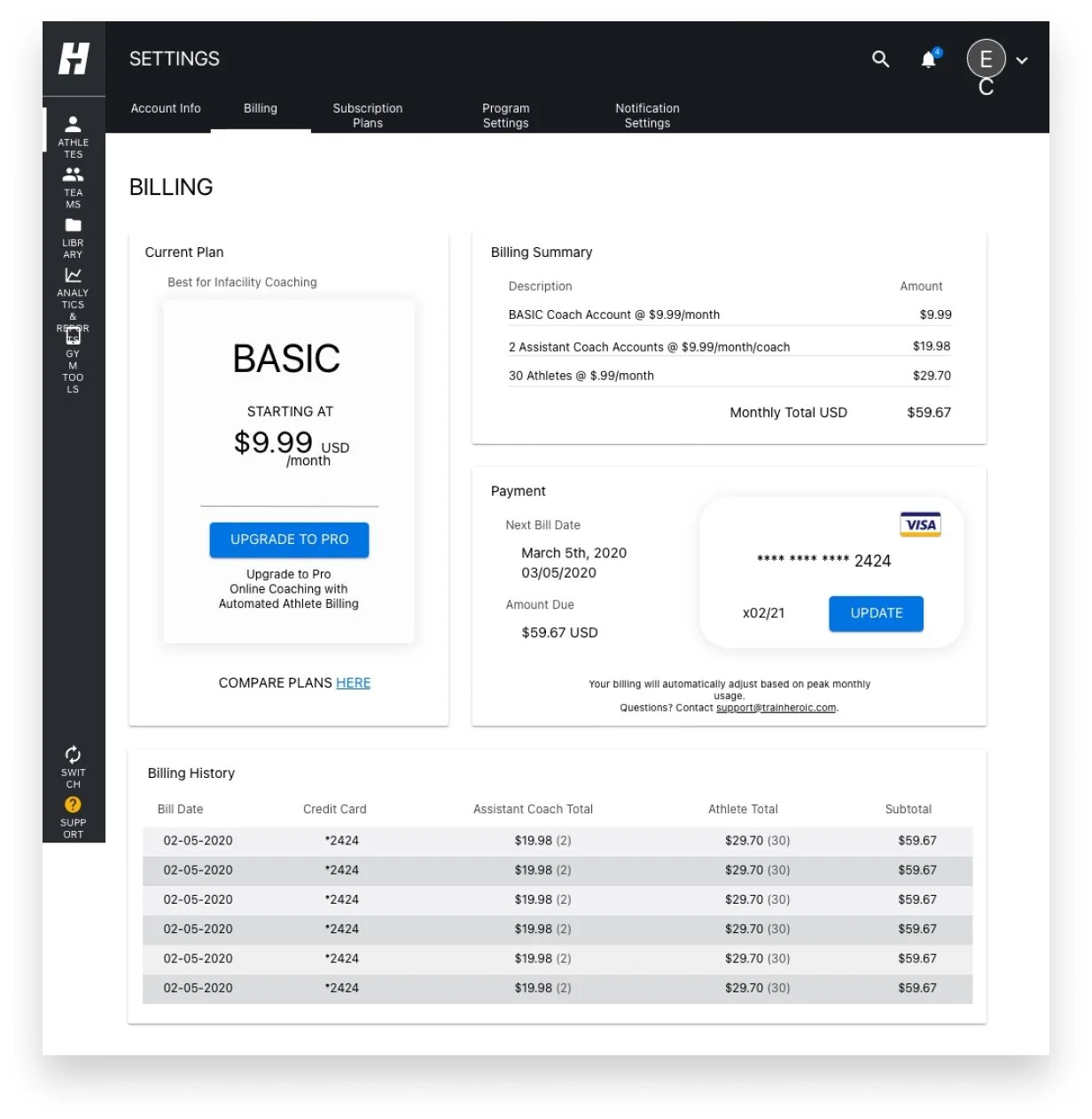Marketing Website | TrainHeroic
-
Goals
Allowing prospective customers to quickly enter the coaches free trial funnel.
-
Team
Ben Crookston Founder & Product Owner
DJ Horton VP Marketing
-
My Role
Lead UX Designer
I was responsible for helping to define scope and specifications, designing the marketing website and admin flows, and documentation for hand-off.
Background
TrainHeroic is a SaaS platform for strength and conditioning coaches and athletes to develop and discover training programs and communities, and to enjoy the journey of training.
I joined TrainHeroic in 2017 as a Customer Success advocate and quickly adopted additional responsibilities paralleling UX Research, Design, and Product Management. Within my 4 years at TrainHeroic, I completed a UX Design course through General Assembly, and contributed to 3 major design projects, including an athlete onboarding, coach dashboard, and was tasked to lead the Marketing Website re-design project.
Problem
Through survey and VoC feedback from prospective and current customers, we discovered that our Coach SaaS pricing model felt inaccessible for coaches working with less than 25 clients, or coaches who were just starting their business. In addition, the 3 tiered plans did not offer much flexibility, and certain features were only available at the highest tier. As a result, our pricing was not attractive to personal trainers and start-ups, a large cohort of our target user.
We suspected that by introducing a flexible pricing model, we could increase our reach to personal trainers and start-ups. The pricing model would allow coaches to “flex” their plan based on the number of athletes they were coaching.
With the risk of switching not only pricing models but also changing the business model to product-led growth, the importance of showcasing a new, simplified pricing model on the marketing website was imperative for our efforts to land new customers.
Homepage Navigation
With new competitive pricing, we wanted to make sure our pricing was at the forefront of our marketing site. This required us to review the navigation menu.
SITEMAP
First, we created a Sitemap to illustrate the navigation in the current state, and which pages would be included in the scope of the project.
The coach pricing was nested beneath ‘For Coaches’ and a secondary CTA on the ‘Learn More’ page. While our primary goal was to get coaches to sign up for a trial, the pricing felt hidden.
The following modification was suggested in relation to pricing update:
Pull ‘Pricing’ into main nav
Overall, the navigation felt complex, but the following suggestions fell out of scope for the project:
Pull support resources into tab, nesting additional resources
Surface contact information in support tab
Pull Marketplace into the navigation
More on navigation in RETRO.
Marketing Site Iterations
In the first iteration of our pricing updates, we created 2 plans:
Basic: A flexible pricing model based on the number of athletes on the account, starting at $9.99/month ($1/month, per athlete)
Pro: $29.99/month for Marketplace access, in addition to $1/month, per athlete
Our primary goals included:
Getting coaches to begin a trial (and later convert to a sale), with multiple CTAs
Showcasing competitive pricing, with a simplified flexible model
Leading with social proof
Answering questions through FAQs
Displaying the range of not only features, but solutions
For background, our sales team had recently been dissolved. Getting coaches to begin a self-serve trial, along with answering some of their most frequently asked questions was an important outcome of the new pricing page.
FINAL ITERATION
In the final iteration, we were met with limitations for what could be built on the marketing website using exiting tools. As a result, the calculator concept was excluded from the final deign. Our team decided to bucket plans based on a range of coached athletes, which we included in a dropdown menu.
ACCOMPANYING UPDATES
With the updates to the pricing model, I proposed automating assistant coach invites, which was previously handled manually by customer service. This allowed us to decrease customer service load significantly, while increasing the revenue through assistant coaches.
As part of these updates, I designed an Assistant Coach section, with explicit costs, and ability to add and remove coaches from their settings.
With changes to the pricing model, this also meant that coaches would not be billed the same amount each month. This meant having a clear billing history for review would be important to coaches.
Results & Retro
This project required both front and backend development in-app to support a new flexible pricing model, and allowed TrainHeroic to shift to product-led growth. This was especially important as the sales team was previously diminished.
While my initial designs also included billing history within the coaches settings, this was cut from scope.
Our KPI’s included the observation of an increase in trials, conversions, and assistant coach sales, however we did see a decrease in overall revenue. This was something we anticipated with the pricing change, and a strategic move to ultimately pivot to a product-led, marketplace model.







